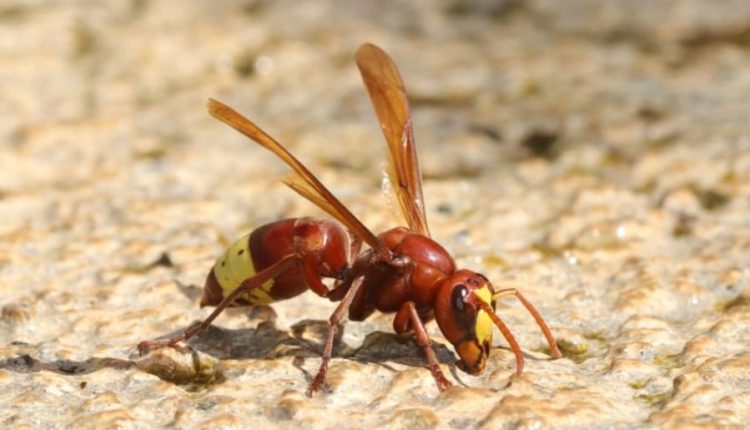
Vespa Orientalis: everything you need to know and how to act in case of an anaphylactic reaction
After a Vespa Orientalis sting, one must calm the child or adult and keep calm by taking him or her to a safe and sheltered place
Vespa Orientalis is an insect that is a member of the order Hymenoptera widespread in Southeastern Europe, the Middle East and Madagascar
However, due to rising temperatures, the Vespa Orientalis has begun to spread to many other areas, including Italy (especially in Latium, Tuscany, Liguria and Friuli Venezia Giulia).
CHILD HEALTH: LEARN MORE ABOUT MEDICHILD BY VISITING THE BOOTH AT EMERGENCY EXPO
Although similar in behavior to the European hornet, this hymenoptera has a more slender appearance reminiscent of a “classic” wasp; it is about 3 cm in length, red in color, and has yellow bands.
Much like bumblebees, this insect creates its nests in the ground, other times in crevices such as tree cavities, abandoned houses.
The colonies that are created reproduce in spring and summer until they reach large sizes in early fall.
Wasp Orientalis is attracted to food scraps found outdoors or in easily accessible places
Like other hymenoptera, it has a stinger connected to glands that contain venom that is released into the skin upon stinging.
In the case of a close encounter with this insect, it is important to remain calm, stay quiet and move away, and avoid both making sudden movements and killing the wasp.
In fact, it must be remembered that these insects sting only if they feel “threatened” in some way.
Especially in case of proximity to a nest, it is good to move away carefully without attempting to kill the specimens or remove the nest on your own.
Removal should always be carried out by trained personnel to operate safely.
Considering that these hymenoptera are attracted to food, it is good to always remove food scraps, especially outdoors.
The sting of Vespa Orientalis can be painful for humans as it is associated with the release of venom by the insect
Human response to wasp sting depends on individual sensitivity and varies from person to person and, with that, the degree of danger.
It should also be remembered that wasp sting can result in a potentially severe anaphylactic reaction in allergic and predisposed patients.
The amount of venom produced by the Wasp Orientalis is very similar to that of other stinging hymenoptera, and it is not a more dangerous hymenoptera than others already present in our latitudes.
After attack, the stinging apparatus inserts itself inside the skin, where it releases venom resulting in local reactions common to all insect bites namely pain, swelling and redness.
The stinger does not remain embedded in the skin (as is the case, for example, with a bee sting), but can be extracted by the animal, which remains alive and can therefore sting repeatedly.
However, this fact should not be alarming since, although it can sting repeatedly, most of the venom is injected at the first sting.
After the sting, it is necessary to calm the affected child and/or person and keep calm by taking them to a safe and sheltered place.
It is also good to wash the affected area immediately with cold water and keep something cold locally.
This will help control the pain and inflammation.
If the pain is intense, you can also apply a corticosteroid cream or combine an oral pain reliever such as acetaminophen, always under careful medical advice.
As with “classic” wasp stings, the sting of the oriental wasp can be particularly dangerous for individuals allergic to the venom. In such cases, anaphylaxis up to anaphylactic shock may occur.
Symptoms of a severe allergic reaction are:
- Urticarial rash (red or rather erythematous and multiple raised lesions called “ponfi.”
- Swelling of the eyes, lips, face;
- Difficulty in swallowing;
- Respiratory difficulty i.e. wheezing, repeated coughing, choking sensation and sense of impending death; and
- Decreased blood pressure;
- Acceleration of heartbeat.
A severe allergic reaction constitutes a medical emergency; should this occur, it is essential to contact help immediately.
Read Also:
Emergency Live Even More…Live: Download The New Free App Of Your Newspaper For IOS And Android
Anaesthesia And Allergic Reactions: Factors To Take Into Account
Does The Recovery Position In First Aid Actually Work?
Insect Bites And Animal Bites: Treating And Recognising Signs And Symptoms In The Patient
What To Do In Case Of A Snakebite? Tips Of Prevention And Treatment
Wasps, Bees, Horseflies And Jellyfish: What To Do If You Get Stung Or Bitten?
What Should Be In A Paediatric First Aid Kit
Wasp Sting And Anaphylactic Shock: What To Do Before The Ambulance Arrives?
Anaphylactic Shock: What It Is And How To Deal With It



